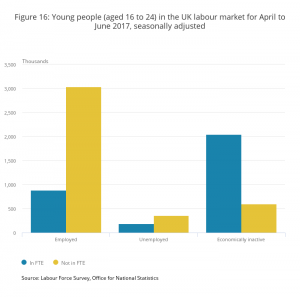The latest ONS data shows the employment rate at 75.1%, at its highest since comparable records began. The data available covers the period from April 2017 – June 2017.
The figures show that the number of people in work increased, the number of those unemployed fell and the number of people aged 16 – 24 not seeking or available to work (economically inactive) also fell.
We take a look at the headlines and the youth unemployment figures in more detail.
The Headlines
- There were 32.07 million people in work, 125,000 more than for January to March 2017 and 338,000 more than for a year earlier.
- The employment rate (the proportion of people aged from 16 to 64 who were in work) was 75.1%, the highest since comparable records began in 1971.
- There were 883,000 people (not seasonally adjusted) in employment on “zero-hours contracts” in their main job, 20,000 fewer than for a year earlier.
- There were 1.48 million unemployed people (people not in work but seeking and available to work), 57,000 fewer than for January to March 2017 and 157,000 fewer than for a year earlier.
- The unemployment rate (the proportion of those in work plus those unemployed, that were unemployed) was 4.4%, down from 4.9% for a year earlier and the lowest since 1975.
- There were 8.77 million people aged from 16 to 64 who were economically inactive (not working and not seeking or available to work), 64,000 fewer than for January to March 2017 and 90,000 fewer than for a year earlier.
- The inactivity rate (the proportion of people aged from 16 to 64 who were economically inactive) was 21.3%, down from 21.6% for a year earlier and the lowest since comparable records began in 1971.
Youth Employment Figures

- 92 million people in work (including 886,000 full-time students with part-time jobs)
- 545,000 unemployed people (including 186,000 full-time students looking for part-time work)
- 65 million economically inactive people, most of whom (2.05 million) were full-time students
For April to June 2017, the unemployment rate for 16 to 24 year olds was 12.2%, lower than for a year earlier (13.6%).
The unemployment rate for those aged from 16 to 24 has been consistently higher than that for older age groups. Since comparable records began in 1992:
- the lowest youth unemployment rate was 11.6% for March to May 2001
- the highest youth unemployment rate was 22.5% for late 2011
Our view
We watch youth employment data closely and whilst we recognise the work going in to sustaining high levels of employment we remain acutely aware of youth employment figures being higher than those of any other group. As we celebrate the successes of our young people and their exam results across the next couple of weeks we must remain committed to ensuring that all young people are supported to realise their full potential.
We appreciate the challenges that come with recording and reporting the data and some of the hidden figures and numbers of young people that go unrecorded in figures. The recent Youth Jobs Index from Impetus PEF raises many concerns you can read the full report here.












